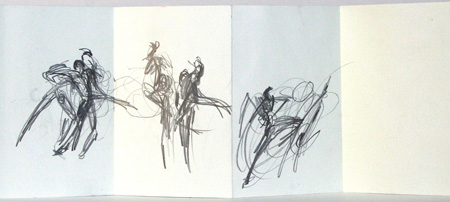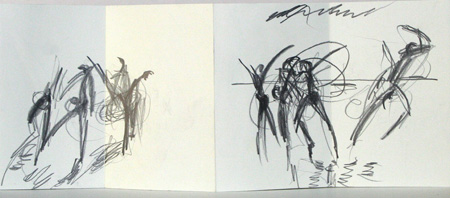On Saturday morning at the Queen Elizabeth Hall in A Feeling For Practice: Trisha Brown in Focus, dancers from the New York based Trisha Brown Company discussed what had attracted them to join the company, the difference of working on archived material and devising new work and about the artistic practice of their Director. One commented that all dance work in New York was a “bridge leading back to Trisha Brown”, another commented that Brown’s early work held “that wild-child raw energy”. Questions followed, put to Trisha Brown by the audience.
The choreographer also talked about her use of drawing in her creative process, as she spoke she said “It’s easier for me to show you” she leapt from her seat and sunk to the floor, lying on her side she held imaginary charcoal which she pushed in front of her on a huge invisible sheet of paper, using her whole body in the act of mark making (she’s over 70). She said she had filled her house with the 8 foot x 10 foot drawings. In the evening the Company performed four dances. Brown’s drawing is the backdrop to You Can See Us, choreographed in 1995.
 Glacial Decoy, made in 1979. The dancers moved in front of a Robert Rauschenberg designed backdrop of four large screens filling the length and height of the stage, showing a quick succession of black and white close up images.
Glacial Decoy, made in 1979. The dancers moved in front of a Robert Rauschenberg designed backdrop of four large screens filling the length and height of the stage, showing a quick succession of black and white close up images.

L’ Amour au Theatre, choreographed in 2009

Opal Loop, choreographed in 1980
Watching the dancers perform in the evening, after hearing them speak so candidly about their experiences extended my appreciation and understanding of the work. Brown was at the forefront of the choreographers coming from the post modern era, always pushing the boundaries of movement and dance, showing her work with the Judson Dance Theatre in the 1960’s. The every day gestures which she introduced to her movement are accepted in dance as normal today but were radical when she first used them.